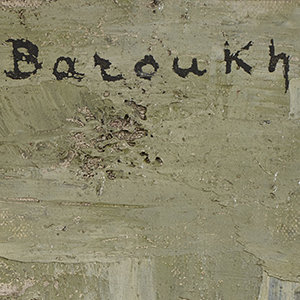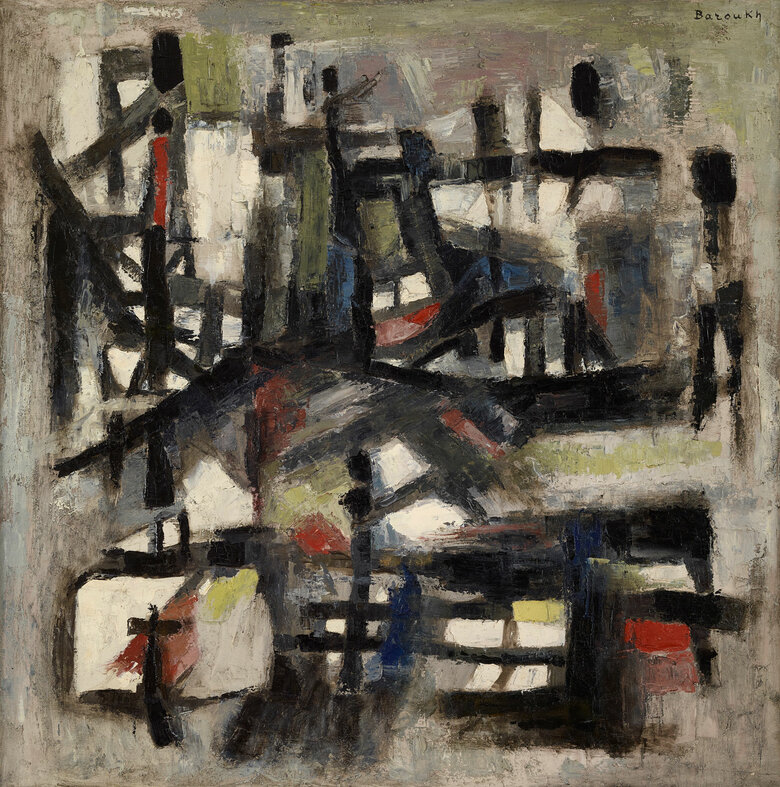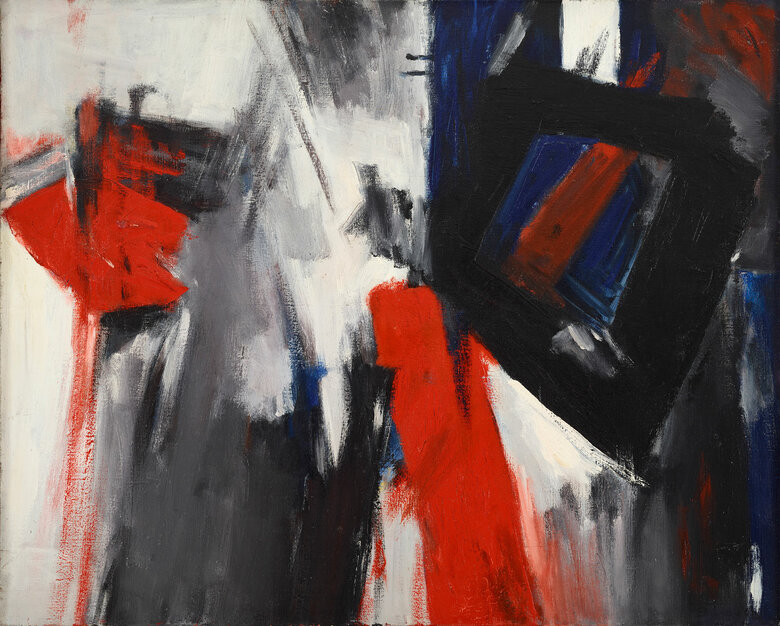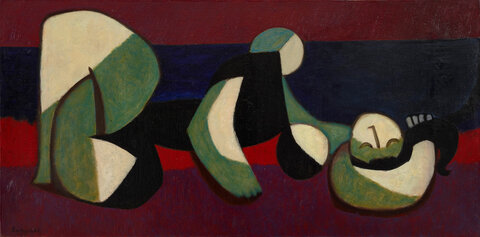A predominantly abstract painter with a great desire for experimentation, Ezekiel Barroukh was a significant artistic contributor during a crucial period in Egypt’s journey towards modernism....


EZEKIEL BAROUKH, Egypt (1909 - 1984)
Bio
Written by MYSA KAFIL-HUSSAIN
A predominantly abstract painter with a great desire for experimentation, Ezekiel Barroukh was a significant artistic contributor during a crucial period in Egypt’s journey towards modernism. Born in 1909 in the city of Mansourah, Barroukh studied at the French Lycée in Alexandria, a prestigious international school established in the early twentieth century.[1] After completing school, he left for Rome to study in the Italian capital’s renowned Accademia di Belle Arti, graduating with a diploma from the Department of Painting in the early 1930s. With Italy deep in the midst of fascism, spearheaded by Prime Minister Benito Mussolini, Barroukh – both an Egyptian and a man of Jewish faith – felt uncomfortable as a foreigner,[2] and chose to return to Egypt in 1934.
Settling back into life in Alexandria, Barroukh began his career as a professional painter, teaching drawing and painting classes, whilst also creating a range of his own still lifes, portraits and landscapes.[3] In 1935, he exhibited his work at both the Italian Club of Alexandria and also at the Salon du Caire, and it was during this time that his art caught the eye of Mohamed Naghi, an accomplished modern Egyptian painter, who encouraged Barroukh to join l’Atelier d’Alexandrie which Naghi had set up just one year before as a space to gather Alexandrian painters.[4] The Atelier became a prominent fixture in Alexandria, and Barroukh himself organized and participated in many of the Atelier’s events between 1940-1946, with his work at this point being predominantly figurative.[5]
The 1930s in particular were a pivotal period for Barroukh, and Egypt itself was going through significant upheaval with the country gaining independence in 1936. Artists began actively pursuing a role in their new, modern country, carving out space for communal creative exploration and gave themselves permission to push boundaries. During this period, Barroukh was working closely with fellow artist Ramses Younan,[6] who in 1938 wrote a rebellious, revolutionary manifesto entitled ‘Vive l'art degénéré’ (or ‘Long live degenerate art’). This manifesto sparked the dawn of a new group – Art and Liberty (Art et Liberté )– headed by Younan and artist George Henein, and providing a new generation of artists, intellectuals and political activists with a platform to explore their culture, resist fascism, nationalism and colonialism, and call for a social revolution with surrealist art and writing at its core.[7] The group wanted to challenge all previous notions of what art could be and achieve, rejecting the notion of “art for art’s sake”[8] and fighting against academic and bourgeois limitations on creativity. Barroukh, who had also become friends with Surrealist writers René Etiemble and Lawrence Durrell,[9] was an active member of the group and present at all five radical exhibitions in 1940, 1941, 1943, 1944 and 1945,[10] although his approach to his work was perhaps not as bold and macabre as other members, developing his own style which combined elements of sensuality, mystery and realism. He also exhibited his work at the Salon du Caire regularly in the early 1940s, before deciding to push his career even further by moving to Paris in 1946. Just two years later, the Art and Liberty group was dissolved, with many members forming ‘The Contemporary Art Group’, diverting away from surrealism and instead focusing on local iconography and popular arts and crafts.[11]
The postwar Parisian art scene was a fascinating environment for Barroukh. André Lhote, a French artist and educator who had visited and taught in Egypt in 1951 and 1952,[12] set up Académie André Lhote in Paris in the 1920s and by the 1940s, it was frequented by many local and international artists, including Effat Naghi and Mohamed Naghi, [13] and also Hussein Bicar and Samir Rafi.[14] Barroukh also attended the Academy in 1952, and took part it in the Salon de Mai that same year with Lhote [15]. His painting titled Baigneuse (‘Bather’, now part of the Dalloul Collection), also painted in 1952 and most likely painted in Paris, gives an insight into the new artistic language Barroukh was seeking to experiment with, using flat colours, geometrical forms and abstraction to create conceptual scenes which borrowed elements from his experiences with the Art and Liberty group. Barroukh’s figure, laid reclining across his canvas, rhythmically following and intertwined with the linear background, but fragmented and dismembered, has roots in the group’s revolt against the idealised naturalism of the bourgeoisie. In deforming and distorting figures, the artists would illustrate the economic justice in Egyptian society, becoming a form of artistic protest.[16] Whilst Barroukh’s figure may not look pained or particularly violently maimed and is in fact a relaxed bather, the remnants of the surrealist techniques of his former colleagues have found their way into his somewhat-cubist composition.
The artist returned briefly to Alexandria for an exhibition in 1954, and then to Cairo, before settling in France permanently. Throughout the 1950s and 1960s, he participated in various exhibitions, including in Chateauroux many times and at Paris’ Galerie A.G., in addition to many editions of Salon de Mai, Salon des Comparaisons, and also the Biennale de Conches in 1961, after which the French State purchased one of Barroukh’s works.[17] After his 1967 solo exhibition at Galerie 9 in Paris, the French State purchased yet another work by Barroukh, firmly establishing him as a highly-regarded and professional artist in his new home.
The 1960s and 1970s sparked a search for a new artistic vocabulary: Barroukh strived to progress and to innovate, leading him to move away from cubism and his previous interpretations of abstraction and towards more informal art.[18]
Experimenting more with monochrome and expressive techniques, this may indeed be the period in which he painted two undated works in the Dalloul Collection, both of which have a spontaneous and strikingly animated contemporary quality – a world away from his early ventures into realism (and occasionally surrealism) and the abstraction and cubism of his post-war works. However, following this period, he returned to figuration and traditional still lifes, whilst also sketching every morning in his favourite Parisian café.[19]
Continuing to work consistently, Barroukh was invited to participate in the 1980 Salon d’Automne and exhibited regularly throughout the early 1980s. In 1984, the National Contemporary Art Fund (Fond National d’Art Contemporain) of France purchased his 1983 painting ‘Le Modèle’, shortly before Barroukh passed away in Paris at the age of 75.[20]
Aside from his three paintings housed in the Dalloul Collection, many of his works are now held in numerous museums across France and in the Barjeel Collection in the United Arab Emirates, as well as in both the Museum of Modern Art in Cairo, and the Museum of Fine Arts in Alexandria, the city he regarded as home.
Notes
[1] Jordan National Gallery of Fine Arts, “Lines of Subjectivity: Portrait and Landscape Paintings, from the collection of Barjeel Art Foundation” (Exhibition Catalogue), Jordan National Gallery of Fine Arts, Amman, 2017, p. 32
[2] Wikipedia, “Ezekiel Baroukh”, Fr.Wikipedia, n.d., https://fr.wikipedia.org/wiki/Ezekiel_Baroukh
[3] Ader Nordmann, “Art Moderne & Contemporain du Moyen-Orient” (Catalogue) Ader Nordmann Auction House, 2017. http://catalogue.gazette-drouot.com/pdf/97/87724/liste2.pdf?id=87724&cp=97
[4] Wikipedia, “Ezekiel Baroukh”
[5] Ader Nordmann, “Art Moderne & Contemporain du Moyen-Orient”
[6] Christie’s, “Middle Eastern, Modern and Contemporary Art, London, 25 October 2017: Lot 18, Ramses Younan – ‘Untitled (Shells)’”, Christie’s Auction House, 2017. https://www.christies.com/en/lot/lot-6098995
[7] Moderna Museet, “Background Art et Liberté”, Moderna Museet, Stockholm, Sweden, 2018. https://www.modernamuseet.se/stockholm/en/exhibitions/art-et-liberte/background-art-et-liberte/
[8] Sam Bardaouil, Till Fellrath, Art et Liberté: Rupture, War and Surrealism in Egypt (1938 - 1948) (Paris: Editions Skira), 2016, p. 55
[9] Francoise Livinec, “Ezekiel Baroukh”, Francoise Livinec Gallery, Paris, n.d.,http://francoiselivinec.com/en/artistes/bio/27111/ezekiel-baroukh
[10] Ader Nordmann, “Art Moderne & Contemporain du Moyen-Orient”
[11] Moderna Museet, “Background Art et Liberté”
[12] André Lhote, “Academy André Lhote”, Andre-Lhote.org, n.d., https://andre-lhote.org/academy
[13] Ibid
[14] Mehri Khalil, “André Lhote and Egypt”, in André Lhote and his International Students, ed. Zeybep Kuban and Simone Wille (Austria: Innsbruck University Press), 2020, p. 177
[15] Ibid
[16] Bardaouil, Fellrath, Art et Liberté: Rupture, War and Surrealism in Egypt (1938 - 1948), p. 87
[17] Ader Nordmann, “Art Moderne & Contemporain du Moyen-Orient”
[18] Francoise Livinec, “Ezekiel Baroukh”
[19] Wikipedia, “Ezekiel Baroukh”
[20] Khalil, “André Lhote and Egypt”, p. 181
Sources
Ader Nordmann: “Art Moderne & Contemporain du Moyen-Orient” (Catalogue). Ader Nordmann Auction House. 2017. Accessed February 2021. http://catalogue.gazette-drouot.com/pdf/97/87724/liste2.pdf?id=87724&cp=97
André Lhote: “Academy André Lhote”. Andre-Lhote.org. n.d. Accessed February 2021. https://andre-lhote.org/academy
Bardaouil, Sam; Fellrath, Till. Art et Liberté: Rupture, War and Surrealism in Egypt (1938 - 1948). Paris: Editions Skira. 2016.
Francoise Livinec: “Ezekiel Baroukh”. Francoise Livinec Gallery, Paris. Accessed February 2021. http://francoiselivinec.com/en/artistes/bio/27111/ezekiel-baroukh
Jordan National Gallery of Fine Arts: “Lines of Subjectivity: Portrait and Landscape Paintings, from the collection of Barjeel Art Foundation” (Exhibition Catalogue, March 9 – May 31 2017). Jordan National Gallery of Fine Arts, Amman. 2017.
Khalil, Mehri. “André Lhote and Egypt”. In André Lhote and his International Students, ed. Zeybep Kuban and Simone Wille, p. 171-188. Austria: Innsbruck University Press. 2020.
“Middle Eastern, Modern and Contemporary Art, London, 25 October 2017: Lot 18, Ramses Younan – ‘Untitled (Shells)’”. Christie’s Auction House. 2017. Accessed February 2021. https://www.christies.com/en/lot/lot-6098995
Moderna Museet: “Background Art et Liberté”. Moderna Museet, Stockholm, Sweden. 2018. Accessed February 2021. https://www.modernamuseet.se/stockholm/en/exhibitions/art-et-liberte/background-art-et-liberte/
Wikipedia: “Ezekiel Baroukh”, Fr.Wikipedia. Accessed February 2021.https://fr.wikipedia.org/wiki/Ezekiel_Baroukh
CV
Selected Solo Exhibitions
1990
Galerie Evelyne Guichard, La Côte Saint André, Isère, France
1989
Uzès, France
1967
Galerie 9, Paris, France
1960
Galerie Saint Germain, Paris, France
1956
Museum of Châteauroux, France
1954
Alexandria, Egypt
1948
Museum of Châteauroux, France
1935
Cercle Italien d’Alexandrie, Alexandria, Cairo, Egypt
Selected Group Exhibitions
2024
60th Venice Biennale - Stranieri Ovunque/Foreigners Everywhere, La Biennale di Venezia, Venice, Italy
2023
UNTITLED Abstractions, Dalloul Art Foundation (DAF), Beirut, Lebanon
2022
Taking Shape: Abstraction from the Arab World, 1950s–1980s, The Block Museum, Evanston, Chicago, Illinois, USA
2021
Monaco to Alexandria: The Great Detour World-Capitals and Cosmopolitan Surrealism, Nouveau Musée National de Monaco, Monaco, Monaco
The Nude: Conflict, Dalloul Art Foundation (DAF), Beirut, Lebanon
2020
Taking Shape: Abstraction from the Arab World, 1950s–1980s, New York University’s Grey Art Gallery, New York, USA
2018
A Century in Flux: Highlights from the Barjeel Art Foundation, Sharjah Art Museum, Sharjah, United Arab Emirates (ongoing until 2023)
2017
Chefs-d’oeuvre de l’art Moderne et Contemporain Arabe, Institut du Monde Arabe, Paris, France
Lines of Subjectivity: Portrait and Landscape Paintings (In association with Barjeel Art Foundation), The Jordan National Gallery of Fine Arts, Amman, Jordan
Comme un paysage, Galerie Françoise Livinec, Paris, France
2016
When Art Becomes Liberty: The Egyptian Surrealists (1938-1965), Palace of Arts, Cairo, Egypt
1983
Groupe 109, Grand Palais, Paris, France
1980
Salon D'automne, Paris, France
1968
Exhibition organized by Jacob Gallery, Galerie At Home, Toulouse, Paris, France
1965
Salon des Comparaisons, Paris, France
1961
Conches Biennale, France
Salon des Comparaisons, Paris, France
1960
Salon des Réalités Nouvelles, Paris, France
1959
Galerie A.G., Paris, France
1958
Salon de Mai, Paris, France
Galerie A.G., Paris, France
1955
Galerie Charpentier, Paris, France
1953
Buhrle Prize Exhibition, Galerie Kaganovitch, Bührle prize exhibition, Paris, France
1952
Contrast groupe exhibition, Lyon, rance
1950
Salon de Mai, Paris, France
1949
Exhibition of the Lauréats of the Hallmark Prize, Paris, France
1948
Salon des Sur-independents, Paris France
1945
Nobilis exhibition, Cairo, Egypt
l’Atelier d’Alexandrie, Alexandria, Egypt
Art et Liberté Group Exhibition, Cairo, Egypt
1944
l’Atelier d’Alexandrie, Alexandria, Egypt
Art et Liberté Group Exhibition, Cairo, Egypt
1943
l’Atelier d’Alexandrie, Alexandria, Egypt
Art et Liberté Group Exhibition, Cairo, Egypt
1942
Salon des Indépendants, Cairo, Egypt
1941
IIe Exposition de l’Art Indépendent (Art et Liberté Group Exhibition), Cairo, Egypt
Art et Liberté Group Exhibition, Cairo, Egypt
1940
Premiere Exposition de l’Art Indépendent (Art et Liberté Group Exhibition), Cairo, Egypt
l’Atelier d’Alexandrie, Alexandria, Egypt
1935
Salon du Caire, Cairo, Egypt
Public Exhibitions
1980
Salon D'automne, Paris, France
1965
Salon des Comparaisons, Paris, France
1961
Biennale de Conches, France
Salon des Comparaisons, Paris, France
1959
Salon de Mai, Paris, France
1952
Salon de Mai, Paris, France
1950
Salon de Mai, Paris, France
Affiliations & Memberships
1938–
1946
Art et Liberté, Cairo, Egypt
Collections
Barjeel Art Foundation, Sharjah, United Arab Emirates
Ramzi and Saeda Dalloul Art Foundation, Beirut, Lebanon
Museum of Modern Art, Cairo, Egypt
Museum of Fine Arts, Alexandria, Egypt
Musée d’Art Moderne de la Ville de Paris, Paris, France
Musée d’Art Moderne, Chateauroux, France
Fonds National d’Art Contemporain, France
Press
Lines-of-Subjectivity_BAFandSUTTON-ARABIC.pdf
A Century in Flux _ Barjeel Art Foundation.pdf
Lines of Subjectivity_ Portrait and Landscape Paintings _ Barjeel Art Foundation.pdf
_ملامح المذهب الذاتي__ عن مئة سنة مضت.pdf
In New York, Arab artists send out a message _ Op-eds – Gulf News.pdf
A ‘Horizon of Infinity’_ The Promise of Arab Abstract Art - Al-Fanar Media.pdf
تواصل معرض «ملامح المذهب الذاتي» في المتحف الوطني الأردني _ صحيفة الرأي.pdf
Release_TakingShape_20190925.pdf
In New York, More Eyes Turn to Middle Eastern Art - Al-Fanar Media.pdf
Taking Shape_ Abstraction from the Arab World, 1950s–1980s _ The Brooklyn Rail.pdf
Press-Release-IMA-Barjeel-Art-Foundation-Arabic.pdf
Release_TakingShape_20190925 (1).pdf
Taking Shape _ 4Columns.pdf
Art and Liberty.pdf
EZEKIEL BAROUKH Artwork
Become a Member
Join us in our endless discovery of modern and contemporary Arab art
Become a Member
Get updates from DAF
Follow Artists
Save your favourite Artworks
Share your perspectives on Artworks
Be part of our community
It's Free!
We value your privacy
TermsCookiesPrivacy Policies
Become a Member
Get updates from DAF
Follow Artists
Save your favourite Artworks
Share your perspectives on Artworks
Be part of our community
It's Free!
We value your privacy
TermsCookiesPrivacy Policies
Become a Member
Get updates from DAF
Follow Artists
Save your favourite Artworks
Share your perspectives on Artworks
Be part of our community
It's Free!
We value your privacy
TermsCookiesPrivacy Policies
Welcome to the Dalloul Art Foundation
Thank you for joining our community
If you have entered your email to become a member of the Dalloul Art Foundation, please click the button below to confirm your email and agree to our Terms, Cookie & Privacy policies.
We value your privacy, see how
Become a Member
Get updates from DAF
Follow Artists
Save your favourite Artworks
Share your perspectives on Artworks
Be part of our community
It's Free!
We value your privacy
TermsCookiesPrivacy Policies








